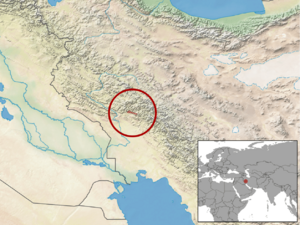Luristan newt facts for kids
Quick facts for kids Luristan newt |
|
|---|---|
 |
|
| Conservation status | |
| Scientific classification | |
| Genus: |
Neurergus
|
| Species: |
kaiseri
|
 |
|
| Synonyms | |
|
Neurergus crocatus kaiseri Schmidt, 1952 |
|
The Luristan newt (also called the Kaiser's mountain newt or emperor spotted newt) is a very colorful type of salamander. It belongs to the Salamandridae family. This special animal lives only in the southern Zagros Mountains in Iran. It has been found in just four streams there.
Sadly, the number of these newts has been going down. Because of this, the International Union for Conservation of Nature says it is a "vulnerable" animal. This means it could be in danger of disappearing. To help, some zoos have started a program to breed these newts.
Contents
Where Luristan Newts Live
The Luristan newt is found only in the southern Zagros Mountains in Iran. When we say it is "endemic" to this area, it means it doesn't naturally live anywhere else in the world.
Luristan Newt Habitat
These newts mostly live in streams high up in the mountains. These areas are often dry and surrounded by scrubland. You can also find them in ponds and pools. They are known from only four streams, all in one small area.
For much of the year, there is no water in their habitat. During these dry times, the newts move into the nearby forests. These forests have mostly oak and pistachio trees. When they move away from the water, they go into a special resting state called estivation. This is like hibernation, but it helps them survive hot, dry periods.
Future Habitats for Luristan Newts
Scientists have studied where the Luristan newt lives now. They think that in the future, due to climate change, these newts might spread to other parts of southern Iran. These areas include Kermanshah, Ilam, Chaharmahal-Bakhtiari, and Kohgiluye-Boyerahmad. This is because their current homes might become too difficult to live in.
Protecting the Luristan Newt
The Luristan newt is considered a "vulnerable" animal. This is because it lives in a very small area that is also broken up into smaller parts. Its home is getting smaller, and people are illegally catching these newts to sell them.
In 2008, experts thought there were fewer than 1,000 Luristan newts left in the wild. But a new study in 2014 gave better news. It estimated that there were over 9,000 adult newts. This study also suggested that there could be enough habitat for more than 40,000 of these newts.
International Protection Efforts
To help protect the Luristan newt, international trade of this animal needs a special permit. This is because it is listed on CITES Appendix I. CITES is an agreement that helps control the trade of endangered plants and animals.
Many zoos in Europe and North America have started programs to breed these newts. One example is the Sedgwick County Zoo. Iran is also planning to start its own breeding program. These programs help make sure the species doesn't disappear.
Caring for Luristan Newts
Sometimes, Luristan newts are sold as "captive bred" animals. This means they were born and raised in zoos or special breeding facilities, not caught from the wild. These newts can be quite strong and healthy if they are kept in the right conditions.
Setting Up Their Home
Three adult newts can live comfortably in a twenty-gallon terrarium. It's important to give them plenty of both land and water. These newts usually only go into the water during their breeding season. This is because they live in dry areas in the wild.
If you keep them mostly on land, use a good, but fairly dry, top-soil or coconut fiber. Add many live plants and lots of places for them to hide. The best temperature for them is between 60 to 68 degrees Fahrenheit (15 to 20 degrees Celsius). They can handle temperatures up to 86 degrees Fahrenheit (30 degrees Celsius).
What Luristan Newts Eat
Feeding these newts is usually easy because they are good eaters. They enjoy foods like earthworms (also called Canadian night-crawlers). They also like live or thawed blackworms and blood-worms. You can give them small crickets dusted with calcium. Occasionally, they can have waxworms and other small insects.
It's important to avoid feeding them insects caught from outside. These insects might carry harmful pesticides or parasites.


